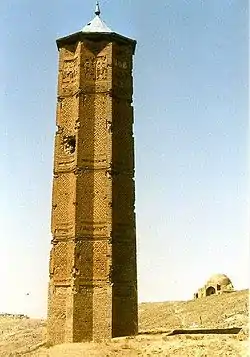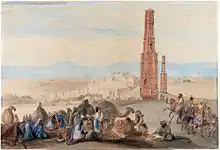Ghazni Minarets
Ghazni Minarets are two elaborately decorated minaret towers located in Ghazni city, central Afghanistan. They were built in middle of the twelfth century and are the only surviving elements of the mosque of Bahram Shah. The two minarets are 600 meters (1968 feet) apart and lie in an open plain, north-east of Ghazni city.[3]
 One of the Ghazni Minarets as seen in 2001. | |
 Ghazni Location in Afghanistan | |
| Alternative name | Mas'ud III Minaret & Bahram Shah Minaret[1] |
|---|---|
| Location | Ghazni, Afghanistan |
| Region | Ghazni Province |
| Coordinates | 33°33′52.4″N 68°26′01.8″E |
| Type | Minaret |
| Height | 20 m (66 ft) |
| History | |
| Builder | Masud III, Bahram-Shah of Ghazna |
| Material | Bricks |
| Founded | 12th Century |
| Site notes | |
| Condition | Endangered |
Both minarets of Ghazni are 20 metres (66 feet)[4] tall and built of fired mud brick. The surface of the towers are decorated beautifully with intricate geometric patterns and Qurunic verses on elaborate terracotta tiles. In the 1960s, both towers were fitted with sheet metal roofs in a limited preservation effort.[4]
History
The 12th century minarets are the most famous monuments of Ghazni city and are among the last surviving remnants of the great Ghaznavid Empire. The two minarets are called, Mas'ud III Minaret and Bahram Shah Minaret after the ruler who built them, Mas'ud III (A.D. 1099-1115) and Bahram Shah (A.D. 1118-1157).[1] The excavated palace of Mas'ud III lies nearby to the towers.[3]

The minarets were taller before the upper sections were damaged and destroyed over time. Part of the Masud III minaret top was destroyed in an earthquake in 1902.[4]
Threats
Ghazni Minarets are not well preserved or protected. Both towers are in danger from natural elements and the political instability in Afghanistan. There are no basic security measures in place to prevent vandalism and the towers are in need of new roofing to prevent water infiltration into the towers.[4]
The towers' facade contains intricate geometric patterns and Quranic inscriptions which are deteriorating rapidly with exposure to rain and snow. They are further affected by the nearby road and the area is subject to periodic flooding.[4]
Gallery
_(14766244092).jpg.webp) An illustration of a Ghazni Minaret in "The story of architecture" by Mathews, Charles Thompson, 1896.
An illustration of a Ghazni Minaret in "The story of architecture" by Mathews, Charles Thompson, 1896. U.S. Heritage Documentation Program surveying minarets in July 2011.
U.S. Heritage Documentation Program surveying minarets in July 2011. The plains with the Ghazni Minarets, 2010.
The plains with the Ghazni Minarets, 2010.-_Menschen_-_Annemarie_Schwarzenbach_-_SLA-Schwarzenbach-A-5-21-147_(cropped).jpg.webp) Photo of minaret in 1939-40 by Annemarie Schwarzenbach.
Photo of minaret in 1939-40 by Annemarie Schwarzenbach. "The fortress and citadel of Ghazni (Afghanistan) and the two Minars", a painting by James Atkinson in 1839 AD.
"The fortress and citadel of Ghazni (Afghanistan) and the two Minars", a painting by James Atkinson in 1839 AD.
References
- "072. Ghazni: Bahram Shah Minaret". cemml.colostate.edu. Retrieved 19 September 2018.
- "Ghazni Towers Documentation Project: History". eca.state.gov. Retrieved 19 September 2018.
- "Ghazni Minarets". wmf.org. World Monuments Fund. Retrieved 19 September 2018.